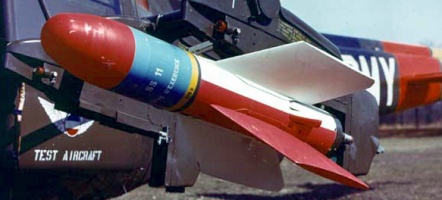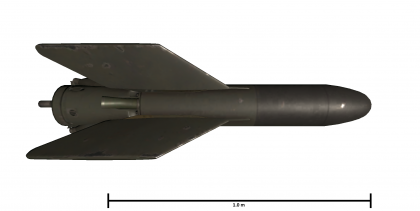SS.11

Contents
Description
The SS.11 (SS = French: sol-sol or surface to surface), also known as the AS.11 (air-sol) for aircraft-mounted variants, is a manual command to line of sight (MCLOS) wire-guided anti-tank missile developed by French aviation manufacture Nord Aviation. It also served in other Armed Forces in which it received a different name: AGM-22 in the USA, RB 52 for Sweden, and Tagar for Israel.
Developed in the early 1950s, the SS.11 began production in 1956 and was fielded in the French military. Initially launched from ground vehicles, the French found success in launching these surface-to-surface missiles from fixed-wing aircraft during the Algerian war (1958-1662) in an air-to-ground application. The French went further to adapt this missile to also be fired from a helicopter platform. The Alouette II was the first helicopter outfitted with the SS.11 and was instantly successful at exploiting this weapon. The Alouette had the ability to work its way to a target which could not be duplicated with fixed-wing aircraft and became a force multiplier with much success in so that when Alouette III helicopters began production, they were already configured to accept the SS.11 as one of the many armaments available for use.
Being classified as an MCLOS, the SS.11 is not a fire-and-forget type missile which will home into a target on its own, on the other hand, it requires a missile operator to "fly" the missile to its target. The missile is connected to the firing vehicle throughout its flight by a series of very thin wires. Communications conducted through the wires allowed the missile operator to guide the flying missile to its target allowing some movement around barriers and obstacles if needed. If the target was outside of the range of the total length of wires, the wires would disconnect and the missile would become an unguided rocket until it either hit its target or crashed into another object or ran out of fuel and crashed.
Vehicles equipped with this weapon
| Vehicles equipped with this weapon | |
|---|---|
| Helicopters | |
| USA | UH-1B · UH-1C |
| Germany | ◄SA 313B Alouette II · ◄UH-1D |
| Britain | Wessex HU Mk.5 · Scout AH.Mk.1 · Wasp HAS.Mk.1 |
| France | ▄H-34 · SA 313B Alouette II · SA 316B Alouette III |
| Sweden | HKP2 |
| Ground vehicles | RakJPz 2 · ▄Strv 81 (RB 52) · AMX-13 (SS.11) · Strv 81 (RB 52) · Zachlam Tager |
| Coastal fleet | La Combattante |
General info
| Missile characteristics | |
|---|---|
| Calibre | 164 mm |
| Mass | 29.99 kg |
| Guidance | Manual (MCLOS) |
| Maximum speed | 220 m/s |
| Missile guidance time | 18.5 secs |
| Firing range | 3.5 km |
| Guaranteed launch range | 3 km |
| Explosive mass | 2 kg TNTeq |
| Fuse delay | 0.05 m |
| Fuse sensitivity | 0.1 mm |
| Armour penetration | 600 mm |
Effective damage
Describe the type of damage produced by this type of missile (high explosive, splash damage, etc)
Comparison with analogues
Give a comparative description of missiles that have firepower equal to this weapon.
Usage in battles
Describe situations when you would utilise this missile in-game (vehicle, pillbox, base, etc)
Pros and cons
Pros:
- Wire-guided, allows the operator to guide the missile to the target even potentially "hidden" targets
Cons:
- Limited length of wire, can disconnect and become uncontrollable
- Difficult to use in close, best for targets 500 m away or more
History
- AGM-22
In the late 1950s, the United States military cancelled its evaluation of the SSM-A-23 Dart anti-tank missile and evaluated the proven SS.11 MCLOS anti-tank missile. Upon accepting the French missile into service, the US military changed the designation from SS.11 to AGM-22 (AGM = Air to Ground Missile). The missiles were immediately outfitted to UH-1B helicopters and crews from special units were trained in anti-tank combat tactics. During the Vietnam Conflict, these units were deployed and saw success against armoured targets with the usage of the AGM-22 missiles.
While engaged in the Vietnam Conflict, the U.S. Army in 1966 outfitted their first UH-1B helicopters to carry six of the French-designed SS-11 surface-to-surface missiles mounted on M-22 hardpoints and turned into air-to-ground missiles. The missile was far from a fire-and-forget weapon, due to the fact it required a gunner to track the missile once it was fired all the way to its target. The missile was tracked by a flare lit in the tail of the missile and the gunner would make course adjustments with a joystick to the missile while in flight. The downside to utilising this missile was that it required skilled gunners and a steady platform, difficulties hard to overcome in a battle situation where a hovering helicopter was an easy target. Due to these challenges, the AGM-22 was an unpopular weapon with the helicopter operators and in comparison to the later adopted TOW anti-tank missiles, the -22s were highly inaccurate.[1]
Media
Excellent additions to the article would be video guides, screenshots from the game, and photos.
See also
Links to the articles on the War Thunder Wiki that you think will be useful for the reader, for example:
- reference to the article about the variant of the weapon;
- references to approximate analogues by other nations and research trees.
External links
References
- ↑ McGowen, Stanley S., Helicopters: An Illustrated History of Their Impact (Weapons and Warfare), (2005), ABC-CLIO Publishing, ISBN: 1851094687, p. 351




